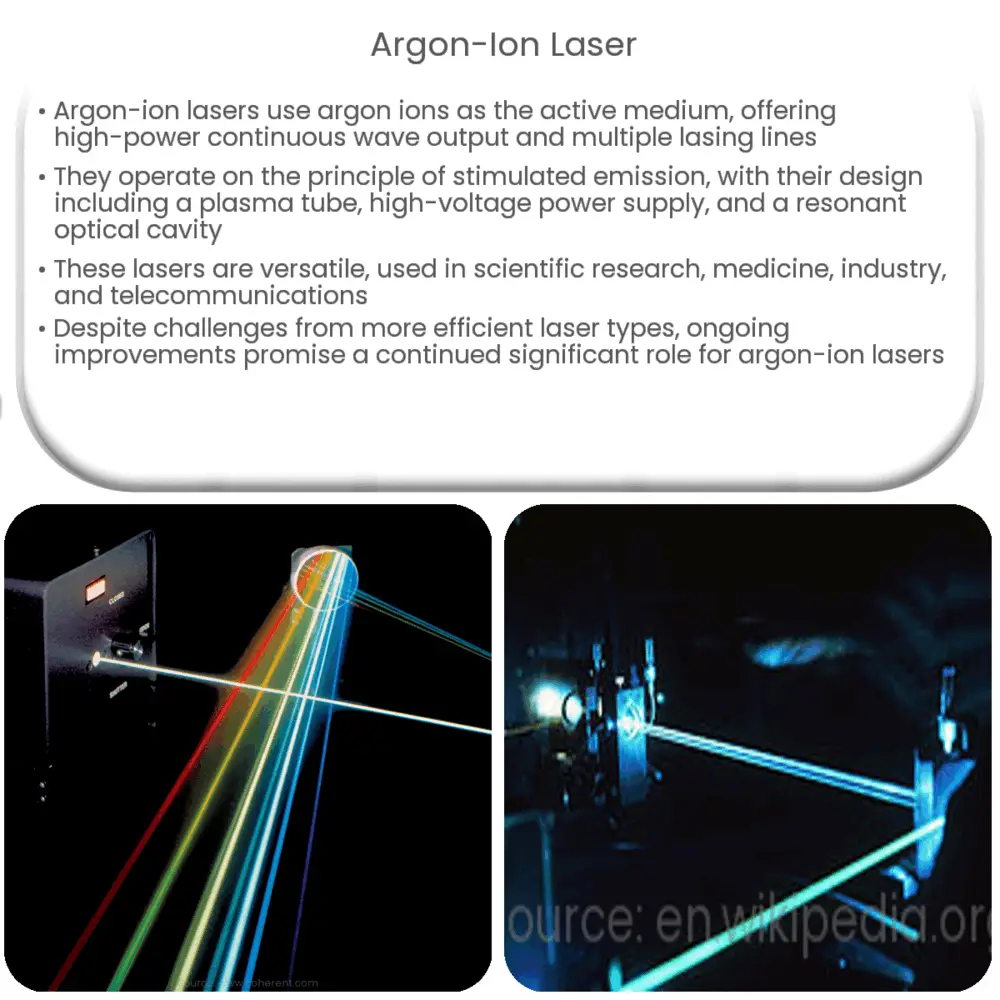Explore the workings, design, applications, and future of Argon-Ion Lasers in this comprehensive guide. Dive into the world of lasers today!”

Introduction to Argon-Ion Lasers
Argon-ion lasers are a class of gas lasers that utilize argon ions (Ar+) as the active medium. Since their development in the early 1960s, they have become an integral part of various scientific, industrial, and medical applications due to their unique properties, such as high-power continuous wave (CW) output and multiple lasing lines across the visible spectrum.
The Operating Principle of Argon-Ion Lasers
The operational principle of the argon-ion laser is rooted in the fundamentals of quantum mechanics. It works on the principle of stimulated emission, a process where an incoming photon of a specific frequency can cause an excited atom or ion to drop to a lower energy state, emitting a second photon of the same frequency, phase, and direction.
The active medium of an argon-ion laser, a noble gas called argon, is ionized in a high-voltage, high-current electric discharge to create a plasma of argon ions (Ar+) and electrons. This plasma is confined within a discharge tube. The energy levels of the argon ions are excited by inelastic collisions with the electrons in the plasma.
Construction and Design
The basic design of an argon-ion laser consists of three major components: a plasma tube to create and contain the argon plasma, a high-voltage power supply to generate the plasma, and a resonant optical cavity to amplify and output the laser light.
- The Plasma Tube: The plasma tube is the core of the argon-ion laser where the actual lasing action occurs. It is filled with argon gas, and the ionization is initiated by a high-voltage electric current.
- The Power Supply: This is a high-voltage power source that drives the ionization process within the plasma tube. The applied voltage needs to be sufficiently high to overcome the ionization potential of argon, which is approximately 15.76 electron volts (eV).
- The Resonant Optical Cavity: This component consists of two mirrors placed at either end of the plasma tube. One mirror is fully reflective, and the other is partially reflective, allowing some light to escape as the laser output.
These components are assembled into a robust design that allows argon-ion lasers to operate continuously and reliably, often for many thousands of hours. This reliability, combined with their high output power and versatility, has made argon-ion lasers an indispensable tool in many areas.
Applications of Argon-Ion Lasers
Argon-ion lasers are renowned for their versatility and are employed in a wide range of applications.
- Scientific Research: In scientific labs, these lasers are used in experiments involving spectroscopy, holography, and fluorescence microscopy, among other techniques. Their unique lasing properties make them particularly useful in these areas.
- Medicine: In the medical field, argon-ion lasers are used in various procedures such as ophthalmology for retinal phototherapy, and in dermatology for treating skin conditions like port-wine stains.
- Industry: Industrial applications include material processing tasks like cutting, drilling, and marking materials. The high-power, continuous output of the argon-ion laser is well suited for these tasks.
- Telecommunications: In the era of fiber-optic communication, argon-ion lasers have also found use as light sources for optical transmission systems.
Challenges and the Future of Argon-Ion Lasers
Despite their wide range of applications, argon-ion lasers are not without their challenges. They are relatively large and require significant electrical power to operate, leading to concerns about efficiency and environmental impact. Recent advances in diode lasers and solid-state lasers, which are smaller and more energy-efficient, pose competition to argon-ion lasers.
However, the unique features of the argon-ion laser, like its ability to produce multiple lasing lines in the visible spectrum and its high-power output, ensure it will continue to hold a valuable position in the laser market. Moreover, ongoing research and development efforts are being directed towards improving the efficiency and compactness of argon-ion lasers, promising a bright future for this class of lasers.
Conclusion
In conclusion, the argon-ion laser is an extraordinary tool with diverse applications across scientific research, medicine, industry, and telecommunications. Its distinctive characteristics, such as its high-power output and multiple lasing lines, make it an indispensable asset in many fields. Although challenges related to size and energy efficiency exist, continuous advancements in the field ensure that argon-ion lasers will continue to play a significant role in shaping our technological future.

